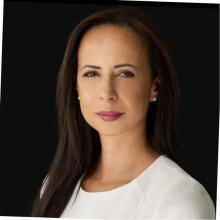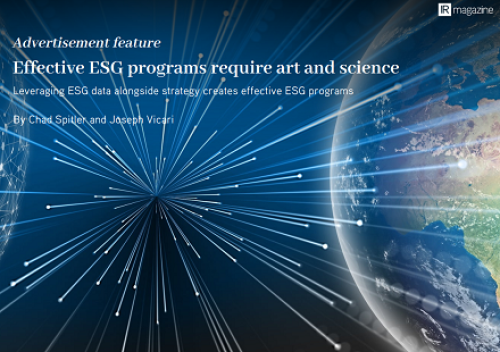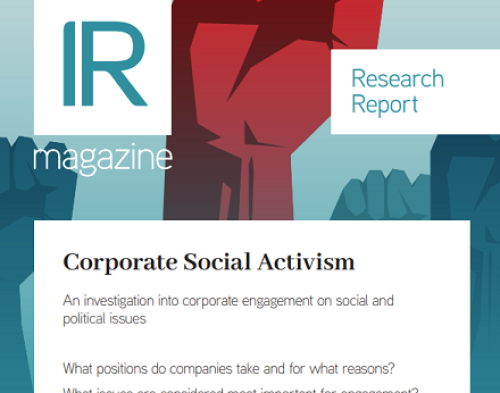The issues shaping societies across the globe, as well as the people that inhabit them, are taking center stage for the investment community. Lack of female representation in leadership positions, limited contribution to climate change efforts and dependence on unsustainable business practices are common concerns worldwide.
Savvy investors are, more than ever, demanding that the companies in which they hold a stake take action. This has resulted in a response from business, including the supporting market eco-system. From regulators and policy-makers to important intermediaries like the sell side and other expert service providers, we all recognize the importance of ESG considerations.
It’s good business sense for the investment community to advocate for necessary change. A recent analysis by Bloomberg Intelligence finds that ESG assets are set to cross the $50 tn mark by 2025, representing more than a third of projected global assets under management. This trend also translates considerably well in the Middle East, a region that is relatively new to ESG requirements, with a recent report by CFA Institute revealing that 94 percent of retail investors in the United Arab Emirates (UAE) are either already investing in sustainable strategies or planning to do so.
Although progress has been made in the areas of governance and – increasingly – recognizing environmental impact, the region’s most prominent challenge remains in addressing its equitability. The evidence for the benefits of increased diversity and inclusion (D&I) in the workplace is significant. A recent McKinsey report finds that companies with greater gender diversity are 25 percent more likely to experience above-average profitability than their counterparts. Likewise, according to private equity firm The Carlyle Group, the average earnings growth of portfolio companies with two or more diverse board members has been nearly 12 percent greater per year than the average of companies that lack diversity.
Against this backdrop, the investor relations function has played a significant role in proactively addressing these issues in response to the investment community, among other important stakeholders. Moreover, being close to the decision-makers, IR can play a pivotal role in framing the discussion as an important pillar for the investment case. The challenge, then, is to manifest these insights in concrete action and, ultimately, change.
During a recent workshop organized by the Middle East Investor Relations Association (MEIRA) D&I Working Group, Sofia El Boury, vice chair of MEIRA and head of IR at First Abu Dhabi Bank, stressed that IR naturally lends itself as an agent of change for D&I given its proximity to the top table of business.
On the same point, Gillian Karran-Cumberlege, co-founder and head of Fidelio’s board practice, reiterated that such leadership requires a concerted effort from individuals, organizations and society at large. As a contributor to change, Karran-Cumberlege added that the UK’s adoption of a nine-year tenure limit – after which directors are no longer deemed independent – in effect created new openings, which was an important factor in moving toward more than 30 percent female representation on FTSE boards.
These global efforts are beginning to emerge in the Middle East, with recent directives introduced by the UAE stipulating that all locally listed companies must appoint at least one woman to their board of directors. The role played by the IR function is one that complements public policy, such as raising discussions around any gender pay gap and taking into account other voices, including those of other stakeholders relevant to the investment community.
On a corporate level, several blue-chip Middle Eastern companies are paving the way for greater D&I in the workplace and across their respective sectors. For example, Zain, a leading telecommunications provider in the region, established a dedicated D&I office to oversee the UN’s Women’s Empowerment Principles, one of several initiatives that aim to institutionalize, if not embed, D&I across the organization. In practice, there are more than 100 champions throughout the company charged with living and sharing the values of D&I by way of example.
Although considerable focus must be placed on the public and private sectors to progress D&I, effective communication between companies, policy-makers and investors must be present. During the MEIRA workshop, Alicia Gallego-Martinez, the marketing, communications and events manager at MEIRA, highlighted that often companies are doing the right things, but not necessarily telling people about them. To complete this key process, corporate reporting and a clear and consistent narrative come to the fore, emphasizing the strategic nature of communications, including investor communications or IR.
Through a robust and engaging IR function, one built on transparency and cross-functional expertise between both internal stakeholders – like human resources – and external audiences, IR acts as the conduit for the C-suite and board of directors. At the same time, IR addresses the needs of investors. In effect, strategic communications have become a source of differentiation for companies in the competition for capital.











